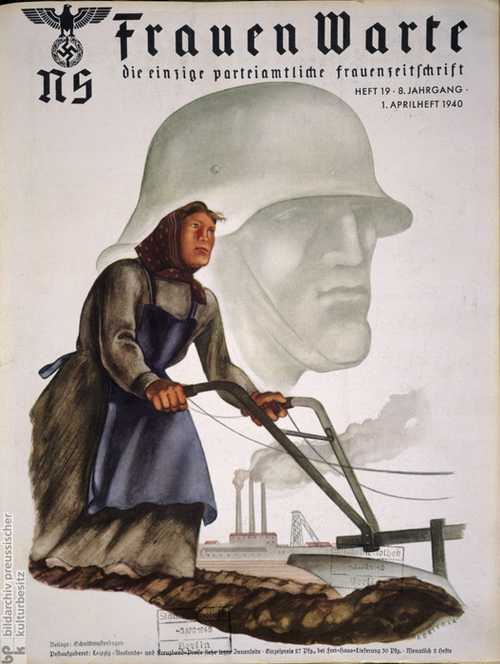
Posters Artwork Documents
A woman's work ...
Prussian State Archive
... is never done. Cover page from "Frauen Warte", National Socialist magazine directed at women, dated 1 April, 1940. The message is clear - it is up to women to keep the home front working while the man is off at war. The date is interesting. Compared to Great Britain, and subsequently the US and the Soviet Union, Germany was slow to harness the power of womens' labour to the war effort. At the date of this image, Germany was still far from having implemented a war economy; in fact, at this stage, the regime tried as far as possible to maintain a sort of "normality". There were, however, problems in particular areas of the economy, notably agriculture. Whatever about Walter Darré's image of the ideal existence of the German farmer, agriculture was, in fact, a highly labour-intensive activity, especially in the tillage and dairy sectors. This area came under particular pressure from the loss of male manpower to the Forces, and to another loss of muscle-power - the huge demand of the Wehrmacht for horses, that deprived agriculture of much of its principal non-human muscle-power. A mere few months later, the Germans were already requisitioning horses in France; this imposed extreme pressure on French farmers (who were still expected to produce) but may have relieved some pressure on German farms. A little later, further relief came from the allocation of foreign forced labourers to the agricultural sector. That having been said, resentful French, Polish and Russian slaves were not an ideal workforce. The little woman, as in this case, would be expected to manage and "do more with less". She was still stuck, as in this image, behind the plough ... that is, assuming that she still had a horse. Another interesting aspect of this image - given its date so early in the war - is the smoking industrial plant in the background. While Germany was particularly slow to recruit women to industry, it had already happened through natural economic forces to a limited extent. Perhaps the artist with "Frauen Warte" felt a need to hint at a burden, or opportunity, for German women that would only be fully realized somewhat later ? Best regards, JR.
1941 Views
11/22/2006
